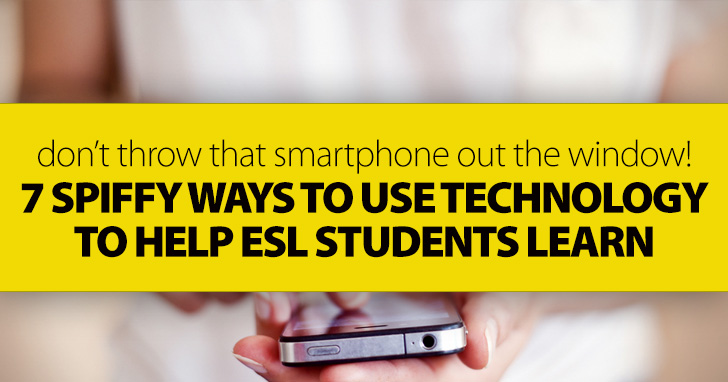Would You Mind Speaking Up?: 5 Must-Have Tools for Improving Spoken English


Well maybe instead of getting frustrated you should put them to work. We live in an age of technology, and instead of fighting our students to keep it out of the classroom, we can do a lot more good by pointing technology in a positive direction. There are lots of ways technology can help ESL students learn. Here are just a few ways to use technology in your classroom to help your students further their language learning.

Whether you are teaching advanced students or beginning beginners, they might have a great picture dictionary right at their fingertips (or in their pants pocket). Any smart phone can be used as a makeshift picture dictionary with no special aps needed. A simple image search on an unfamiliar vocabulary word will, in most cases, produce enough pictures of any word so that your students can infer its meaning. If you like, encourage students to make their own hard copy picture dictionary for your next vocabulary unit by printing out those images and collecting them in a blank notebook or on sheets of paper. If you want, you can even do the image search yourself and use the pictures you come up with when you introduce the new words to your students.
If you are teaching content areas, you may find that your students struggle to understand lecture alone. You can bring technology into your classroom as a means to helping your students understand and absorb general information when language is a barrier. Do a video search on your topic and play excerpts for your students. Not only will these excerpts be a different way to present the same information to your students, you can also use them as listening comprehension activities, and what student doesn’t like watching videos in class?
Almost every cell phone or tablet has an option for recording videos. While this can add up to great fun the next time you have your students write their own skits, you can use this tool to help improve their pronunciation on a regular days, too. Many ESL students do not always realize what their pronunciation is actually like. We hear our own voices in our head the way we want them to sound, no matter if we are native speakers or second language learners. The next time you do a pronunciation activity, go around the room and video your students speaking using their phones or tablets. After they are finished, have them go back and watch the video listening closely to their pronunciation. They may be surprised to hear what they are really saying, and the camera might pick up any unusual body language as well. Students can then use that information to improve their spoken English. If you don’t have time to record all of your students, have them record themselves with the reverse camera option on their cell phones. You can also have pairs of students work together to record and then analyze their pronunciation videos.
If you teach ESL overseas, it might be difficult finding conversation partners for your students. That’s not the case, however, when you use Skype or facetime to connect with English speakers around the globe. If you are looking for conversation partners for your students and don’t have anyone local who is willing to come into the classroom, tap into your connections back home. Find a teacher who is willing to take a few minutes out of class each week to talk over the internet. With a partner over the ocean, students can share what they are learning, talk about their activities outside of the classroom, or work together on projects. Both classes will benefit from the experience academically and personally.
Independent learning centers are great for ESL students, but they often take time to prepare. Take a shortcut by putting a tablet preloaded with level appropriate aps in a learning center in your classroom. You can find aps on just about every topic in English – vocabulary development, reading comprehension, pronunciation…you name it. Even if you don’t have a technology device hanging around, you can still make a center work. Print off a list of free aps that your students can download and use in that center on their smart phones or other devices. That way they can not only learn independently in class but will also have the aps available when they go home.
When you are looking for topics for your students to write or speak about, have them find their own inspiration on Instagram. With a simple cell phone your students can have access to pictures from all over the world – exciting places and interesting people are just waiting to inspire your students. Have students work with a partner to talk about a picture. They can review verb tenses, practice using vocabulary, or describe the people and places they see. If a picture is worth a thousand words, your students will never lack for topics to talk and write about.
Don’t forget one of the easiest ways to help your students learn through technology – Busy Teacher! We have thousands of printables, lesson plans, and worksheets that are easy to find with a simple search. For many of them, all you need to do is print and walk into your classroom. One thing a teacher never has enough of is time, and Busy Teacher is here to help you make class planning a breeze and to share the great ideas other teachers have used and found effective.